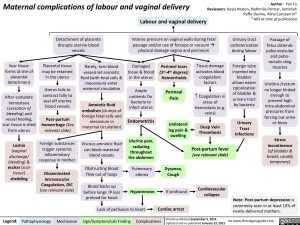Maternal complications of labour and vaginal delivery
Author: Yan Yu Reviewers: Kayla Nelson, Radhmila Parmar, Jemimah Raffe-Devine, Alina Constantin* * MD at time of publication
Labour and vaginal delivery
Detachment of placenta disrupts uterine blood vessels
Intense pressure on vaginal walls during fetal passage and/or use of forceps or vacuumà physical damage vagina and perineum
Urinary tract catheterization during labour
Foreign tube inserted into bladder allows easier colonization of bladder & urinary tract by bacteria
Urinary Tract Infections
Passage of fetus distends pubo-vesicular and pubo- rectalis sling muscles
Urethra /rectum no longer kinked
enough to prevent high intra-abdominal pressures from forcing out urine or feces
Stress incontinence
(of bladder & bowel; usually temporary)
Scar tissue forms at site of placental detachment
After complete hemostasis (cessation of bleeding) and vessel healing, scar tissue is shed from uterus
Lochia
(vaginal discharge/ bleeding) & eschar (scar tissue) shedding
Placental tissue may be retained in the uterus
Uterus fails to contract fully to seal off uterine blood vessels
Post-partum hemorrhage (See relevant slide)
Foreign substances trigger systemic inflammatory response in mother
Disseminated Intravascular Coagulation, DIC (see relevant slide)
Rarely, torn blood vessels let amniotic
fluid (with fetal cells & meconium) enter maternal circulation
Amniotic fluid embolism (clumps of foreign fetal cells and meconium in maternal circulation)
Viscous amniotic fluid can block maternal blood vessels
Obstructing blood flow out of lungs
Blood backs up before lungsàless preload for heart
Damaged tissue & blood in the uterus
Ample nutrients for bacteria to infect uterus
Endometritis
Uterine pain, radiating throughout the abdomen
Pulmonary edema
Hypotension
Perineal tears
(1st-4th degree);
Hemorrhoids
Perineal Pain
Unilateral leg pain & swelling
Dyspnea, Cough
If profound
Cardiac arrest
Tissue damage activates blood coagulation factors
Coagulation in areas of hemostasis (e.g. veins)
Deep Vein Thrombosis
Post-partum fever
(see relevant slide)
Cardiovascular collapse
Lack of perfusion to heart
Note: Post-partum depression is commonly seen in at least 10% of newly-delivered mothers.
Legend:
Pathophysiology
Mechanism
Sign/Symptom/Lab Finding
Complications
Initially published September 5, 2013 on www.thecalgaryguide.com Updated and re-published January 23, 2021
Foundations
Systems
Other Languages
Obstetrics Labor Maternal Complications of Labor and Vaginal Delivery Maternal-complications-after-labor-and-vaginal-delivery

